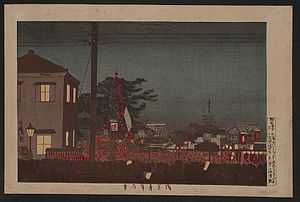Kobayashi Kiyochika


Kobayashi Kiyochika (小林 清親, September 10, 1847 – November 28, 1915) was a Japanese ukiyo-e artist of the Meiji period.[1]
Kiyochika is best known for his prints of scenes around Tokyo which reflect the transformations of modernity. He has been described as "the last important ukiyo-e master and the first noteworthy print artist of modern Japan... [or, perhaps] an anachronistic survival from an earlier age, a minor hero whose best efforts to adapt ukiyo-e to the new world of Meiji Japan were not quite enough".[2]
The son of a government official, Kiyochika was heavily influenced by Western art, which he studied under Charles Wirgman.[3] [4] He also based a lot of his work on Western etchings, lithographs, and photographs which became widely available in Japan in the Meiji period. Kiyochika also studied Japanese art under the great artists Kawanabe Kyōsai and Shibata Zeshin.[5]
His woodblock prints stand apart from those of the earlier Edo period, incorporating not only Western styles but also Western subjects, as he depicted the introduction of such things as horse-drawn carriages, clock towers, and railroads to Tokyo.[5] These show considerable influence from the landscapes of Hokusai and the work of Utagawa Kuniyoshi, but the Western influence is also unquestionable; these are much darker images on the whole, and share many features with Western lithographs and etchings of the time.
These were produced primarily from 1876 to 1881; Kiyochika would continue to publish ukiyo-e prints for the rest of his life, but also worked extensively in illustrations and sketches for newspapers, magazines, and books. He also produced a number of prints depicting scenes from the Sino-Japanese War and Russo-Japanese War, collaborating with caption writer Honekawa Dojin to contribute a number of illustrations to the propaganda series Nihon banzai hyakusen hyakushō ("Long live Japan: 100 victories, 100 laughs").[6] [7][5]
Notes
- ↑ Lane, Richard. (1978). Images from the Floating World, The Japanese Print, pp. 193-194.
- ↑ Lane, p. 193.
- ↑ "Japan Holds the String When Russia Reaches to Grasp". World Digital Library. Retrieved 24 May 2013.
- ↑ Boscaro, Andrea et al. (1995). Rethinking Japan: Literature, Visual Arts & Linguistics, p. 135., p. 135, at Google Books
- ↑ 5.0 5.1 5.2 Merritt, Helen et al. (1995). Guide to Modern Japanese Woodblock Prints, 1900-1975, p.71., p. 71, at Google Books
- ↑ "Farewell Present of Useful White Flag, Which Russian General's Wife Thoughtfully Gives When He Leaves for Front, Telling Him to Use It As Soon As He Sees Japanese Army". World Digital Library. Retrieved 24 May 2013.
- ↑ "Kuropatkin Secures Safety - Your Flag Does Not Work, Try Another". World Digital Library. Retrieved 24 May 2013.
References
- Boscaro, Andrea; Franco Gatti and Massimo Raveri. (1990). Rethinking Japan: Literature, Visual Arts & Linguistics. New York: St. Martin's Press. 10-ISBN 031204819X/13-ISBN 9780312048198; 10-ISBN 0312048203/13-ISBN 9780312048204; OCLC 21523936
- Lane, Richard. (1978). Images from the Floating World, The Japanese Print. Oxford: Oxford University Press. 10-ISBN 0192114476/13-ISBN 9780192114471; OCLC 5246796
- Merritt, Helen and Nanako Yamada. (1995). Guide to Modern Japanese Woodblock Prints, 1900-1975. Honolulu: University of Hawaii Press. 10-ISBN 082481732X/13-ISBN 9780824817329; 10-ISBN 0824812867/13-ISBN 9780824812867; OCLC 247995392
External links
| Wikimedia Commons has media related to Kobayashi Kiyochika. |
- Shizuoka Prefectural Museum of Art
- Sino-Japanese War print exhibition at MIT
- Prints from Nihon banzai hyakusen hyakushō ("Long live Japan: 100 victories, 100 laughs")
|